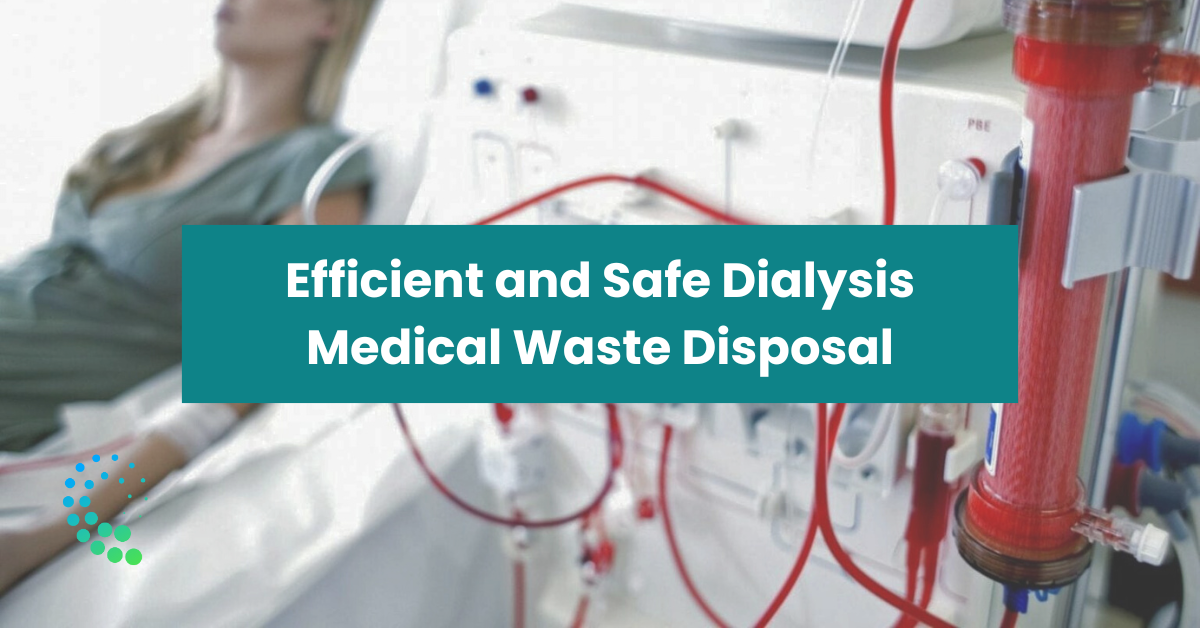
How To Identify The Different Types of Pharmaceutical Waste
August 11, 2024As a dialysis center operator, you understand the critical importance of providing high-quality care to your patients. However, an often-overlooked aspect of this care is the proper disposal of medical waste generated during dialysis treatments. Dialysis medical waste disposal is a crucial aspect of maintaining a safe and hygienic environment for both patients and staff.
Dialysis treatments generate a significant amount of medical waste, including contaminated needles, tubing, and other disposable items. Improper disposal of this waste can pose serious health risks, such as the spread of infectious diseases and environmental contamination. Consequently, it is essential to implement efficient and safe dialysis medical waste disposal practices to ensure the well-being of your dialysis center.
Importance of efficient and safe dialysis waste disposal
Efficient and safe dialysis waste disposal is not just a legal requirement; it is a moral obligation to protect the health and safety of your patients, staff, and the broader community. By following best practices for dialysis waste disposal, you can:
1 - Minimize the risk of exposure to infectious agents and biohazardous materials
2 - Prevent environmental contamination and pollution
3 - Comply with relevant regulations and guidelines
4 - Maintain a clean and hygienic treatment environment
5 - Enhance your dialysis center's reputation and credibility
Failure to properly dispose of dialysis medical waste can result in severe consequences, including legal penalties, reputational damage, and potential health risks to your staff and patients.
Regulations and guidelines for dialysis waste disposal
Dialysis medical waste disposal is subject to strict regulations and guidelines established by various governmental and industry bodies. These regulations aim to ensure the safe and responsible handling and disposal of medical waste, protecting public health and the environment.
Some of the key regulations and guidelines that govern dialysis waste disposal include:
Occupational Safety and Health Administration (OSHA) Bloodborne Pathogens Standard: This standard outlines specific requirements for the handling, storage, and disposal of potentially infectious materials, including dialysis medical waste.
Resource Conservation and Recovery Act (RCRA): This federal law regulates the management and disposal of hazardous waste, including certain types of medical waste.
State and local regulations: Many states and municipalities have their own specific regulations and guidelines for medical waste disposal, which may be more stringent than federal requirements.
Industry guidelines: Organizations such as the Centers for Disease Control and Prevention (CDC) and the Association for the Advancement of Medical Instrumentation (AAMI) provide best practice guidelines for medical waste management in healthcare facilities, including dialysis centers.
It is crucial that you and your staff are familiar with and adhere to these regulations and guidelines to ensure compliance and maintain a safe and responsible dialysis waste disposal program.
Best practices for dialysis waste disposal
To ensure efficient and safe dialysis waste disposal, it is essential to follow best practices throughout the entire waste management process, from segregation and storage to transportation and final disposal. Here are some key best practices to consider:
Waste segregation: Properly segregate different types of medical waste, such as sharps, infectious waste, and non-infectious waste, at the point of generation. This helps to prevent cross-contamination and facilitates proper disposal methods.
Proper containment: Use appropriate containers and packaging materials designed for medical waste. Sharps containers, biohazard bags, and leak-proof rigid containers are essential for safe containment and transportation.
Labeling and identification: Clearly label all medical waste containers with the appropriate biohazard symbol and other required information, such as the generator's name, address, and waste classification.
Storage and handling: Store medical waste in a secure, designated area away from patient care areas and public access. Follow proper handling procedures to minimize the risk of exposure or spills.
Staff training: Provide regular training to all staff members involved in the handling and disposal of dialysis medical waste. Ensure they understand the potential risks, proper procedures, and the importance of compliance with regulations.
Documentation and record-keeping: Maintain accurate records of medical waste generation, storage, transportation, and disposal. This documentation is essential for compliance purposes and can help identify areas for improvement in your waste management program.
Partnering with a reputable waste disposal provider: Consider working with a licensed and experienced medical waste disposal provider that specializes in handling and disposing of dialysis medical waste. These providers can ensure compliance with regulations and provide safe, efficient, and environmentally responsible disposal services.
Conclusion: Ensuring the well-being of dialysis centers through efficient and safe waste disposal
By adhering to best practices, implementing advanced technologies, and partnering with reliable waste disposal providers, you can create a safer environment for your patients and staff, protect the environment, and ensure compliance with relevant regulations.

Free Medical Waste Compliance Checklist
Take control of safety in your organization. Download this checklist to keep your staff and patients safe.

